Veneer plaster
My name is Ryan Frisbie and I have been doing mainly interior thin coat plaster for the last 8 years. I stumbled upon your webpage and looked through all of the jobs you have done, I was blown away. I live in Michigan and here it is so hard to convince people how much better real plaster is over drywall and eifs. Throughout my career like I said I have done mainly thin coat plaster with a base coat and lime finish over blue board either smooth or textured but I have also done conventional plastering, exterior cement plaster, lots of cornice work, off-sets and medallions/rosettes. Here in Michigan we mainly only work in multi-million dollar custom homes, they seem to be the only people willing to pay for plaster. Right now we are actually doing a house where the home owner is replicating a house from the 1700's from the siding to the light fixtures the windows you name it its all 1700's style. The house was all framed with rough cut lumber to create rolls and hollows in the walls, we went through and hung the whole house with wood lath and applied grounds and we just started browning it with a sand mud brown coat. I am just so glad to have found someone who is as adamant as I am about the quality of plaster over the new age cheaper lower quality products, I can't even begin to tell you about how many calls I get from home owners asking me to fix a water damaged eifs jobs or builders calling me in to come fix an awful drywall job. One way I show home owners how strong plaster is I drag a six inch drywall knife down browned wall that set over night and sparks fly off the knife and it doesn't damaged the basecoat, it usually blows them away then I tell them now try that with drywall and see what happens. Well I have taken up enough of your time keep up the good work!

Veneer plaster, sometimes called thin coat plaster, has been around since the 1950's. It is a great alternative to drywall, and is less expensive than conventional lath and plaster.
The surface is durable, but you can still kick a hole in the wall. For high abuse surfaces like hospital corridors, jails, etc. conventional plaster should be used.
There are two methods, the two coat system where a thin plaster basecoat is used, and a one coat system, where the finish coat is directly applied to the board.
Veneer plaster is applied on blue board, which is wallboard that is color coded blue. Examples of blue board are "Imperial board" from United States Gypsum and "Kal-core" from National Gypsum. Veneer plaster base should never be confused with the blue mold resistant wallboard that has come out in recent years, or green board, a water resistant board for drywall.
Plaster finishes for the One coat system are very hard and contain fine sand. Recommended finish materials for one coat are Diamond finish, Imperial finish and Norfolk veneer. Other finish materials such as lime and gauging plaster, or Red top finish plaster should never be used directly on blue board without a basecoat. They are weak, the joints will crack and the material scrapes off the wall easily.
Diamond finish and Imperial finish are very difficult to work with, and may be fine for a rough finish, but it is hard to achieve a suitable smooth trowel finish. Norfolk veneer, however provides a suitable finish with one coat. I found it hard to trowel, meaning it is like pushing a car with your trowel.
I think Norfolk Veneer is made in Norfolk, Virginia and is widely used in the Tidewater area of Virginia, where a lot of plaster is still used. It is also used frequently in Roanoke and Richmond. I had to drive all the way to the other side or Richmond to buy it. Norfolk veneer is unknown here in Northern Virginia, and in fact, plaster is pretty much unknown here. I think we are the last ones here that still plaster houses.
The one coat still allowed us to finish a huge kitchen and dining room area the same day. They were putting on the wood trim and cabinets the next.
Before applying the finish, the joints must be taped. Using the the two coat method, we use a self stick mesh tape. When I worked for a plaster company years ago in Richmond, the old buzzards insisted the staple on tape was better, so we didn't use the self sticking kind.
I have seen Norfolk Veneer jobs that had cracks at the joints when they used mesh tape. Preferable results are achieved by using paper drywall style tape and Durabond, a setting type drywall compound. I think USG changed the name of Durabond to "Sheetrock" compound. This should not be confused with Easy Sand setting compound, that is weak and too soft for this use.
The procedure is to tape the joints with Durabond, and fill in the butt joints and deep areas. As soon as this sets up, the finish plaster can be applied. The two coat method is our method of choice. The basecoat allows filling and straightening of deep areas and provides incredible strength for a thin coat. Also, the basecoat is hard and porous, and supports practically any kind of plaster finish.

The procedure is to tape the joints with a mesh tape, then scratch a coat of veneer basecoat mortar on the joints and immediately come back and coat the whole wall. The wall can be troweled being careful to leave the surface rough enough for a good bond for the finish. Another method is to put on a thin scratch coat and a thin double up coat, and rough the surface by dragging a broom across. This method allows for a thick basecoat and a thin finish coat.
Years ago, we used to use Red Top finish plaster, or Gold Bond finish plaster over the veneer basecoat. This premixed finish plaster was fast because it could mixed with a drill, and troweled easy, unlike Imperial and Diamond. The problem with these finish plasters is that they are gauged too light, meaning they contain about three parts lime and one part gauging. This leads to catfaces (voids) due to shrinkage, and a comparatively weak surface.
Most plasterers I know just use a lime and gauging or a lime and molding plaster finish. This produces a far superior product to the premixed finish plaster, even though it isn't recommended by the manufacturer. This allows the plaster to gauge the finish mortar heavy, meaning about half and half. This is what we do and have excellent results.
Another finish that we do a lot of is Keene's Cement, lime and fine white sand. Keene's cement is a gypsum plaster that sets slow, allowing large areas to be done with a single batch. This is preferred for color plaster finishes, which we do a lot of, and for textures. Keene's is used a lot in California where decorative textures are preferred. Another advantage of Keene's is that is super hard, and water resistant, allowing the walls to be scrubbed.
Veneer plaster isn't cheap, but is quite a value. One problem is the price of plaster materials has nearly tripled in last ten years making plaster out of reach for some budgets. Bob Vila did our industry a lot of good as a salesman. Nearly ever project he did had veneer plaster.
Enough for now, Please keep checking back for more.